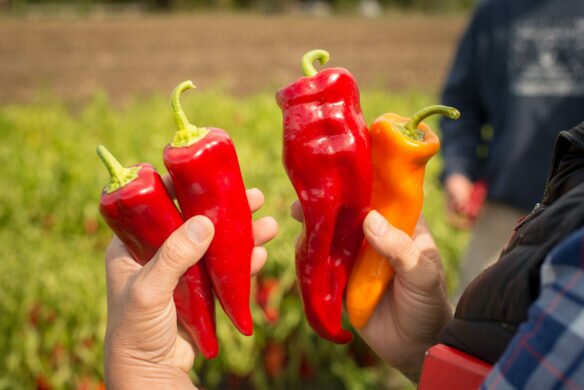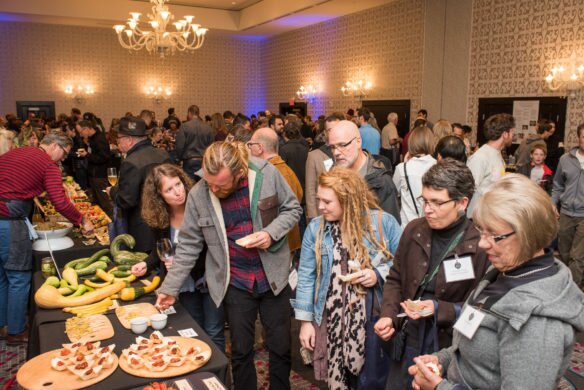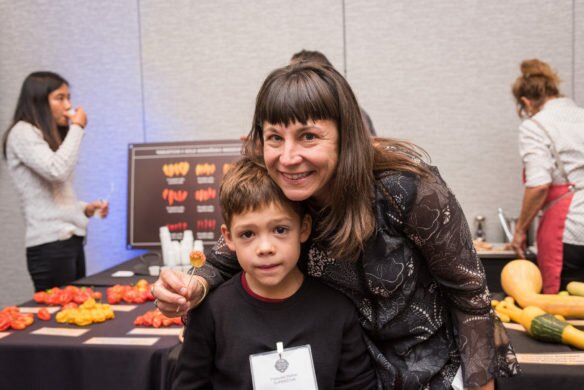2017 27.2 Culinary Breeding Network Bridges the Gap Between Plant Breeders and Eaters
It all started with peppers. As an agricultural researcher for Oregon State University based in Portland, OR, Lane Selman was already managing several regional, participatory breeding trials in the area. At the same time she was helping manage a Portland area farmer’s market stand for Gathering Together Farm from Corvallis, OR.

| Open-pollinated sweet roasting peppers (left to right) ‘Stocky Red Roaster’ (x2), ‘Joelene’s Rustic Italian’ and ‘Gatherer’s Gold’; bred by Wild Garden Seed. Photo by Shawn Linehan. |
In the trials, part of a national organic breeding project called the Northern Organic Vegetable Improvement Collaborative, regional growers were trialing public breeding material alongside commercially available varieties. Through the course of this process, many growers shared frustration that several of their favorite hybrid varieties were disappearing from seed catalogues and the remaining varieties available fell short on flavor and other desirable traits for market. They wanted better performing, openpollinated options that were dependable from year to year.
Peppers, specifically, were chosen as a focus crop within the regional group of growers Selman coordinated in Oregon. After gathering this initial feedback, plant breeder Frank Morton of Wild Garden Seed got involved.
After a few years, he was successful in developing several new varieties of red roasting peppers. Standard field data for these peppers (like yield and shape) exceeded expectations, but there was also a need to capture the amazing flavor these new peppers offered. Using her chef contacts from Portland area farmer’s markets, Lane connected the dots and arranged for cooking and tasting evaluations of the peppers. This was the informal beginning of the Culinary Breeding Network.
Selman is now the Founder/Director of the Culinary Breeding Network, which is comprised of plant breeders, seed growers, farmers, chefs, produce buyers and others in the food community engaged in developing and identifying varieties and traits of culinary excellence for vegetables and grains. The mission is to bridge the gap between breeders and eaters to improve agricultural and culinary quality in vegetables and grains.
Following on the success of these and subsequent tasting trials, Selman created the Variety Showcase that is held each fall in Portland. Now entering its fourth year, the Variety Showcase has attracted chefs, eaters, farmers and researchers from across the country and become a central activity for the Culinary Breeding Network. At this evening tasting event, participants interact with breeders, learn about new varieties as well as taste novel ways that chefs prepare and use these crops. Many are also introduced to multiple varieties of less common crops or new ways of eating more commonly known foods. As an example from the first year, thirteen varieties of Thai basil were packed in oil and tasted side by side. Last year, four types of barley were served as tea, bread, pasta and shortbread cookies.

| Attendees taste samples at the 2016 Variety Showcase. Photo by Shawn Linehan. |
For many university and private plant breeders this event is their main opportunity to interact and get feedback from the general public. Selman says, “They (plant breeders) don’t bring attention to themselves.” She also describes them as reclusive. In comparison, Selman’s gregarious and talkative nature makes her an excellent host for this event and has allowed her to make linkages across groups of people that would not otherwise meet and share information.
“The chefs are really interested and want to be empowered to make better decisions,” Selman says. What the Culinary Breeding Network does is create a gateway for chefs to learn more about the intricacies and difficulties of developing new commercial varieties that are open-pollinated and it also gives breeders and farmers vital feedback on flavor and quality and overall preferences.
For farmers, who often don’t have a lot of time to think about seed and where it comes from, this bond with both breeders and chefs is a boon for their commercial success and creates more opportunities for new crops and new markets.
The Variety Showcase has grown from 100 people to over 300 with a waiting list. At last year’s event in 2016, Selman curated 22 tables that each featured a different type of crop, breeder and culinary creations by both local and national chefs.

| Lane Selman and her son Pasquale at the 2016 Variety Showcase. Photo by Shawn Linehan. |
Portland, being an epicenter for seed growers, farmers, and chefs that are already collaborative in nature, has made this the perfect place to start this work. There are also a lot of experimental eaters in Portland, which Selman believes encourages chefs to try new things.
There are other examples of chefs, farmers and breeders working together around the country and Selman hopes that these opportunities continue to spread beyond the northwest. She highlighted the Seed to Kitchen Collaborative started by Julie Dawson, PhD at University of Wisconsin that focuses on vegetable variety characteristics important to local food systems in the mid-west.
While Selman maintains her work as a researcher for OSU, the Culinary Breeding Network has taken on a life of its own. Events like the Variety Showcase have been supported by grants and donations in collaboration with partner organizations. Selman is also actively collaborating and supporting other food tasting and education opportunities in the region, like Organicology.
The 2017 Variety Showcase will be held in early fall. As this event grows, Selman is excited to welcome new people and ideas to this creative and dedicated community of food lovers. For more information, check out the website: culinarybreedingnetwork.com.
Jessica Gigot, Harmony Fields




